
Venice Biennale 2017 Review by Raju Rage
‘In a world full of conflicts and jolts, in which humanism is being seriously jeopardized, art is the most precious part of the human being’ – Christine Macel, curator of the 57th biennale at Venice.
A claim of this year’s Venice Biennale is that it will ‘open pathways to neo-humanism’. I wasn’t sure exactly how this philosophical ideology, which invokes feelings of connection and care, would manifest itself in a commercial art setting. These terms seem contrary to the workings of the industry and of our current global political situation, where bodies are so often pitted against each other, separated from each other, in competition for resources.
My personal artistic practice explores how bodies are connected and disconnected from each other, questioning who gets to be human, primarily using my own subjective embodied experience and identity in my work as an approach and process of unpacking and healing. Specifically, by using narratives, performance, video and audio in exploring how conflict, memory and trauma manifest in struggle and resistance for non-conforming, gendered and racialized marginalised bodies.
I have never been interested in attending a big biennale, because I’m just not interested in art theme parks. However, this particular theme spoke to me and I was curious.
The first immediate situation that related to bodies, boundaries and borders was who could/couldn’t enter the gates of this event in the first place, in order to access the exhibition preview. It was incredibly difficult to be able to gain entry, even personally for myself as an artist and reviewer, backed by at least two relevant organisations. I watched how certain bodies were checked for ID whereas others weren’t. This created an elitism of who is or isn’t allowed or who is/isn’t important enough to attend, which seemed to defeat the whole point of this theme.
The fictional nation art group NSK curated by Ahmet Öğüt, played brilliantly on this by not setting up a national pavilion but having various booths around the official sites, handing out passports to anyone who wishes to become a citizen, putting refugees, or those who have attempted to flee their home country and been refused papers, in charge of issuing these passports. This worked against the grain since Biennale’s official pavilions, usually represent a country with defined territory, borders and laws. This performative piece allowed people to ‘’rethink what being and belonging might mean,” however, I found this was far too playful rather than the demeaning experienced faced by many people without legal papers, directly impacted in reality. I feel this piece may have been better placed as an enforced entry into the biennale itself, since ironically that became much more harrowing an act in itself.
This left me considering what role art plays in politics or activism, what it can achieve and its limits. Walking around the biennale during the 3-day preview, it was clear that this ‘humanism/humanity’ theme had been embraced with a focus on marginalised bodies, such as migrants, refugees, indigenous peoples and racialized and gendered bodies, but many art works seemed to tokenise and capitalise on these marginal bodies with a tote-bag-politics (credit to Daniella Vals Gen for pointing this out) whilst few others were more nuanced and complex in their interrogation.
The tote bags were EVERYWHERE! which the Biennale promoted ‘During this biennale, it’s more apparent than ever that there’s no better way to broadcast your pavilion or cause than with a tote. “Refugee Rights” and “Indigenous Rights” bags were created to amplify the art works such as the Tracey Moffat (Australian Pavilion) solo show, which unfortunately I did not get to see due to it popularity and huge line to enter.
This reduction of real issues into a snappy capture onto a bag left a sour aftertaste in my mouth. I wonder what it means when issues become a commodity to own and to literally function to put possessions into. It left me thinking about ownership and agency and vital questions as to who owns what: legal papers, lands, rights, bodies. Is ‘art’ really the most precious part of the human being? I’m not so sure.
On the flip side, experiencing the documentation work of Tehching Hsieh’s one year performance’s was like a refreshing glass of cold water soothing the Venetian heat and washing down the superficiality of pseudo ‘political art’. Hseih’s 1980–1981 (Time Clock Piece)
and “One Year Performance 1981–1982 (Outdoor Piece),”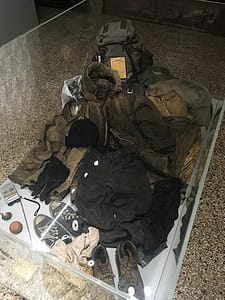
Another favourite art work, about space, which was ironically crammed into the arsenal, similarly from an archive of 1981 to the present was Bonnie Ora Sherk’s ‘A Living Library’,
a displayed collection of images and photographs of her community based projects in San Francisco and New York, which turned underused public spaces into thriving educational art gardens, with animal farms, educational activities, internships and performance art events, for local communities of all ages and backgrounds. This work explores the connection between art ecology and society. This work with clear artistic elements felt more real than just an art work, but an honest, humble collaboration of community, environmental issues and art.
It soon became apparent that most of the art that I enjoyed were actually those shown outside of the official Giardini and Arsenal, scattered around the city of Venice, which they engaged in relationship with. Those that were stumbled upon, through windy roads you inevitably got lost in, across small bridges, amongst an array of everyday Venetians and countless tourists taking selfies, both ignoring street sellers selling mass produced crafted work, like lace fans and Venetian glass, surrounded by gelato stores, aperol spritz cafes, whilst splashing in occasional puddles of water from the rising tide. This connected to the atmosphere of the city which the work felt more a part of, adding to the romantic environment, but also contrasting it in interesting ways.
One such gem was the Diaspora Pavilion occupying a traditional Venetian house at Palazzo Pisano,
which I attended on the busy lively opening night. It was hard to give full attention to all the works by 19 Artists (Larry Achiampong, Barby Asante, Sokari Douglas Camp, Libita Clayton Kimathi Donkor, Michael Forbes, Ellen Gallagher, Nicola Green, Joy Gregory, Isaac Julien, Dave Lewis, Hew Locke, susan pui san lok, Paul Maheke, Khadija Saye, Yinka Shonibare MBE, Erika Tan, Barbara Walker and Abbas Zahedi) interrogating in complexity what ‘diaspora’ means to them, but this felt like an artworld retreat, in a home you had to enter through a ‘glorious golden foil curtain’, a work by Susan Pui San Lok, one you soon lose yourself in, surrounded by people of colour and works by artists of colour, all celebrating and enjoying the night well into the night. A nice contrast to the victimisation narratives that so often stick to marginalised bodies. A highlight was a moving performance by Barby Asante and her guests where Buki sang a moving rendition of ‘Don’t Let Me Down’, something I felt could easily apply to navigating and negotiating the art world as diasporan artists, as well as speaking specifically about being a Black Woman in the western diaspora which Asante’s multiple pieces spoke to, honouring those black women and their contributions.
Khadija Saye’s beautiful bold self-portraits with objects ‘Dwelling: in this space we breathe”, a series of wet plate collodion tintypes, speaks to this specific experience in relationship to her mother. Both tragically passed on 14 June 2017 at the Grenfell Tower Fire in London, a harsh reality and direct reminder of being a marginal body in the diaspora, uncared for by negligent government states. The importance of these portraits is self-evident, in capturing the artist and her mother’s relationship, which will now be embedded in our minds and cherished in our hearts. Most of all the diaspora pavilion is a testament to the diversity of practice of diaspora artists, which goes beyond the Venice Biennale, and exists as a longer-term project that offers support and guidance as well as a platform in which to showcase the artists who are involved works. This commitment to artists of colour’s growth is what is necessary in the art worlds we often participate in but so often are tokenised by.
Dana Whabira’s work in the Zimbabwe pavilion went a necessary step further to critique the colonial encounter between Great Britain ad Zimbabwe, and the impact on black bodies when they are reduced. Whabira raises important questions around language, the violence of translation, control, exploitation, economies and capitalism using sculpture, drawings, neon and audio.
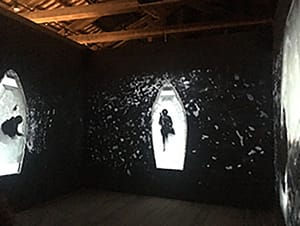
So many works, in the Venice Biennale, such as Candice Breitz’s, speak to the refuge crisis and endurances of global migration. This to me locates problems with borders and boundaries and representation. But leaving the South African pavilion I found myself asking who gets to represent whom? A question clearly demonstrated purposefully by Breitz with selected white Hollywood actors who speak the narratives of people of colour, in order to prove a point.
But I left confused as to why this was unquestioned in the actual curation of the pavilion, where a white south African artist was given much more space than a Black South African Artist to raise relating issues. Whose work was allowed the space to breathe, was privileged and whose ended up suffocated? This was amplified upon later reading that most of the artists at the Venice Biennale were majoritively white artists. I left the biennale questioning how much art about migration, particularly by white artists, speaking on behalf verses an embodied knowledge, we could experience or consume. This left me wondering what other art could be made that questions borders, margins and humanity without victimising or exploiting the black and brown body. This became increasingly hard to digest. Furthermore, I noticed that most of the works focused on marginalised bodies were video works, which reminded me of Arthur Jafa’s statement “The camera functions as surrogate for the white gaze’’ a residual thought I have been chewing on for a while that seemed apt to this context, where there was a strong sense of gaze and voyeurism accompanied by a liberal sense of unity and universalism as a resolution to issues of inequity. This seemed too simplified and not nuanced enough.
Why not, instead, centre artists who have an embodied experience of migration and give them a platform, without the need to exploit these narratives. If this was actually ‘art for arts sake’ as curator Macel speaks out to us, then why not just platform talented black artists and artists of colour who just make art? Wouldn’t that in itself be a resolution to some of the marginalisation in the world? Surely the art world cannot resolve all the problems of inequity in the world, but this is something that it can do?
Whilst wandering Venice Biennale, in search of decent art and refreshment, I came across stencils on decaying walls that stated
‘ANONYMOUS STATELESS IMMIGRANT PAVILLION’,
which I’m assuming is a radical political statement against the Venice Biennale and its arts nationalism, though there are a few rebellious participations this year such as the aptly named ‘Objection’ pavilion. I wish I could’ve visited this pavilion beyond its imaginary. Its absence definitely created a visible presence.
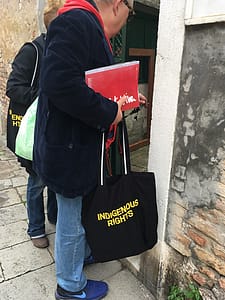
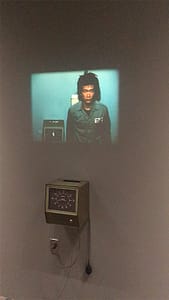
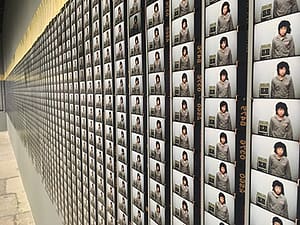
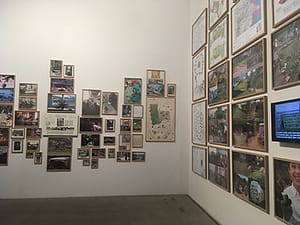
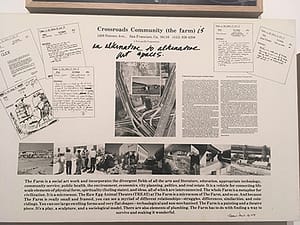
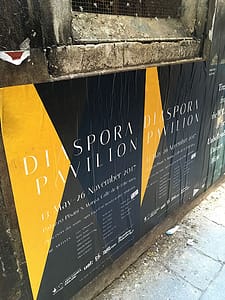
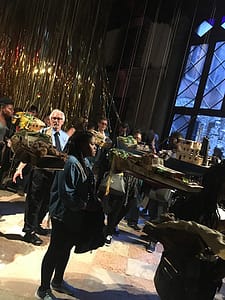
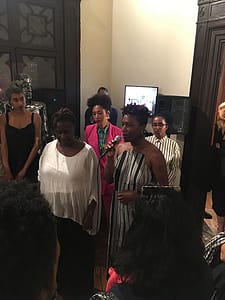
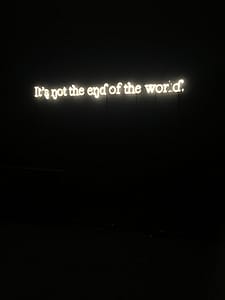



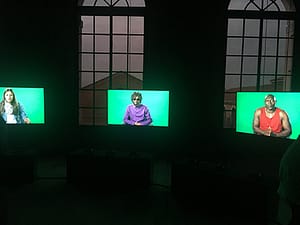

Comments are closed, but trackbacks and pingbacks are open.